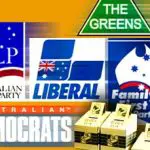
Political parties are organisations made up of people with similar views and values about government, economics and society. It is comparatively easy to start a political party. The Australian Electoral Commission (AEC) will register a political party if the applicant can pay a small fee and provide the signatures of 500 enrolled voters. This shows that the aspiring party has enough support to be worthy of formal registration. Some political parties form to represent a broad group of people or an ideological position. Other parties may form to represent an interest group, niche or policy area, such as the Bullet Train for Australia Party, the Help End Marijuana Prohibition (HEMP) Party and the Shooters and Fishers Party. A full list of political parties can be found here. Once a political party has at least one member elected to parliament, it is is known as a parliamentary political party.
In Western liberal democracies, including Australia, political parties serve as an intermediate structure between the people and government. It is impossible to consider or understand the Australian political system or government without an understanding of our various parties, who and what they represent and how they function. Australia has dozens of different political parties, though only a few are widely known. Most Australians support or identify with at least one political party, and will vote for that party at elections. Those who do not support or vote regularly for one political party are known as ‘swinging voters’.
Political parties serve a number of purposes. They enable diverse interests to be collected, articulated and represented. They facilitate two-way communication between the people who formulate policy and the electorate. They are the major actors in formulating policies and in communicating those policies to the electorate. They simplify our choices and provide stability to our parliamentary system of government. Let’s face it – without major parties, forming government from our parliament would be chaotic if not impossible. In some respects, political parties have come to dominate government in Westminster systems. The government of the day is really the party of the day. Elections are essentially contests between parties. Legislatures are chambers organised into and dominated by parties. Westminster-style politics is party politics. Political parties are central to almost all levels of political activity, debate and decision-making.
Since 1910, the main feature of Australian politics has been the contest between Labor and non-Labor parties. The Australian Labor Party (or ALP) has, broadly speaking, represented the interests of labour and the working and middle classes for all of that period. Representing urban and business interests since 1944 is the modern Liberal Party. Representing rural interests is the National Party, previously known as the National Country Party and the Country Party. The modern Liberal and National parties work together in a tight coalition. This coalition dates back to the 1940s, though it has twice suffered short-lived fractures.
While major political parties are often depicted as unified and coherent in their thinking, in practice this is most unusual. Successful political parties tend to be broad churches of conflicting, sometimes contradictory, interests and ideologies. Most parties are divided internally, with contending factions of competing interests, political theories and worldviews. Behind their facades of unity, there are significant differences of opinion within all of the major political parties in Australia. While the major parties often exaggerate their differences to appeal to voters, they sometimes have more in common with each other than they would care to admit. Furthermore, the policies and priorities of both parties are constantly evolving. The Labor Party today is markedly different to the Labor Parties led by Whitlam, Chifley, Scullin and Fisher. Similarly, the Liberal Party of today differs to parties led by Fraser, Menzies, Lyons, Hughes, and Deakin.
In addition to the two major party groupings, there have been dozens of minor parties on the Australian political scene. From time to time these parties have been able to exercise some influence – even significant influence on occasions – over Australian politics and government. In the last 20 years the Australian Democrats and various Green parties have been able to influence or curtail the legislative agenda of governments. In the 1990s Pauline Hanson’s One Nation Party demonstrated significant electoral support. Independent members of parliament also get elected to Federal and State legislatures from time to time. In recent years these minor parties and independents have been able to capitalise on growing disillusionment with two-party politics and the behaviour of the major parties.
© lawgovpol.com 2014. Content on this page may not be republished or distributed without permission. For more information please refer to our Terms of Use.
